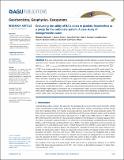Files in this item
Evaluating the utility of B/Ca ratios in planktic foraminifera as a proxy for the carbonate system : a case study of Globigerinoides ruber
Item metadata
| dc.contributor.author | Henehan, M.J. | |
| dc.contributor.author | Foster, G.L. | |
| dc.contributor.author | Rae, J.W.B. | |
| dc.contributor.author | Prentice, K.C. | |
| dc.contributor.author | Erez, J. | |
| dc.contributor.author | Bostock, H.C. | |
| dc.contributor.author | Marshall, B.J. | |
| dc.contributor.author | Wilson, P.A. | |
| dc.date.accessioned | 2015-08-06T10:40:01Z | |
| dc.date.available | 2015-08-06T10:40:01Z | |
| dc.date.issued | 2015-04 | |
| dc.identifier | 206403674 | |
| dc.identifier | a23b5385-694a-45ef-a927-cd9ba5997e3d | |
| dc.identifier | 85027946745 | |
| dc.identifier | 000354746900005 | |
| dc.identifier.citation | Henehan , M J , Foster , G L , Rae , J W B , Prentice , K C , Erez , J , Bostock , H C , Marshall , B J & Wilson , P A 2015 , ' Evaluating the utility of B/Ca ratios in planktic foraminifera as a proxy for the carbonate system : a case study of Globigerinoides ruber ' , Geochemistry, Geophysics, Geosystems , vol. 16 , no. 4 , pp. 1052-1069 . https://doi.org/10.1002/2014GC005514 | en |
| dc.identifier.issn | 1525-2027 | |
| dc.identifier.other | ORCID: /0000-0003-3904-2526/work/60196322 | |
| dc.identifier.uri | https://hdl.handle.net/10023/7133 | |
| dc.description | This research was funded by NERC, Grant Number: NE/D00876X/2. | en |
| dc.description.abstract | B/Ca ratios in foraminifera have attracted considerable scientific attention as a proxy for past ocean carbonate system. However, the carbonate system controls on B/Ca ratios are not straightforward, with Δ[ CO32-] ([ CO32-]in situ - [ CO32-]at saturation) correlating best with B/Ca ratios in benthic foraminifera, rather than pH, B(OH)4-/HCO3-, or B(OH)4-/DIC (as a simple model of boron speciation in seawater and incorporation into CaCO3 would predict). Furthermore, culture experiments have shown that in planktic foraminifera properties such as salinity and [B]SW can have profound effects on B/Ca ratios beyond those predicted by simple partition coefficients. Here, we investigate the controls on B/Ca ratios in G. ruber via a combination of culture experiments and core-top measurements, and add to a growing body of evidence that suggests B/Ca ratios in symbiont-bearing foraminiferal carbonate are not a straightforward proxy for past seawater carbonate system conditions. We find that while B/Ca ratios in culture experiments covary with pH, in open ocean sediments this relationship is not seen. In fact, our B/Ca data correlate best with [ PO43-] (a previously undocumented association) and in most regions, salinity. These findings might suggest a precipitation rate or crystallographic control on boron incorporation into foraminiferal calcite. Regardless, our results underscore the need for caution when attempting to interpret B/Ca records in terms of the ocean carbonate system, at the very least in the case of mixed-layer planktic foraminifera. | |
| dc.format.extent | 1629772 | |
| dc.language.iso | eng | |
| dc.relation.ispartof | Geochemistry, Geophysics, Geosystems | en |
| dc.subject | Globigerinoides ruber | en |
| dc.subject | B/Ca ratios | en |
| dc.subject | Planktic foraminifera | en |
| dc.subject | pH proxy | en |
| dc.subject | Trace elements | en |
| dc.subject | Proxy calibration | en |
| dc.subject | GC Oceanography | en |
| dc.subject | GE Environmental Sciences | en |
| dc.subject | NDAS | en |
| dc.subject.lcc | GC | en |
| dc.subject.lcc | GE | en |
| dc.title | Evaluating the utility of B/Ca ratios in planktic foraminifera as a proxy for the carbonate system : a case study of Globigerinoides ruber | en |
| dc.type | Journal article | en |
| dc.contributor.institution | University of St Andrews. Earth and Environmental Sciences | en |
| dc.contributor.institution | University of St Andrews. Statistics | en |
| dc.contributor.institution | University of St Andrews. St Andrews Isotope Geochemistry | en |
| dc.identifier.doi | 10.1002/2014GC005514 | |
| dc.description.status | Peer reviewed | en |
This item appears in the following Collection(s)
Items in the St Andrews Research Repository are protected by copyright, with all rights reserved, unless otherwise indicated.

